Generations of American women fought hard for the right to vote. They endured mockery, belittlement, and disregard, not to mention retribution, assault, and imprisonment. The first wave in the struggle for women’s suffrage lasted roughly 100 years, coming to an end in 1920 with the ratification of the 19th Amendment. Women finally had the vote.

The race to register women
Though the bill behind the 19th Amendment had been approved by Congress in June 1919, it would take more than a year for the required ratification by state legislatures. By the time Tennessee became the 36th state needed to ratify the amendment and make it law, there were just nine weeks remaining until Election Day 1920.

The League of Women Voters spearheaded many registration efforts. Across the country, the LWV and other organizations sponsored registration picnics, held practice voting sessions, and even produced dramatic reenactments of the voting process.

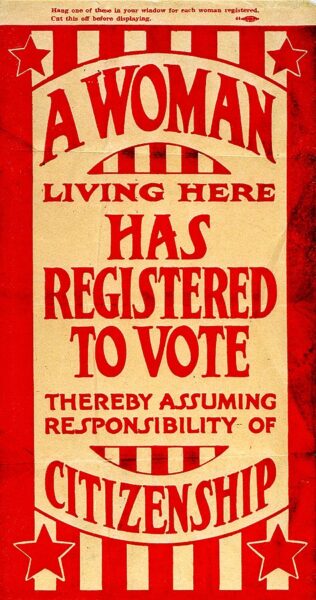

But what would happen when the “weaker” sex went to the polls?
Many politicians at the time were concerned about what a women’s voting bloc could mean. Roughly 26 million American women had been enfranchised. Would women coalesce around certain issues and wield their collective voting power?

“[N]othing has brought so many women of different classes together on a common working basis as suffrage… We have come to know each other as we could not otherwise, and have had our eyes opened to the economic struggle in these United States… the votes of women cast intelligently in the struggle against the present sick economic order may make considerable difference…”
—Stella Crossley Daljord, The Nation, 1920

On Nov. 2, 1920, women across the United States voted for the first time in a presidential election.
Many were voting for the first time in their lives.

When the votes were tallied, Warren Harding was president and Calvin Coolidge vice president. Roughly 26,750,000 Americans had voted, eight million more than in the previous election—an increase that can be attributed for the most part to women voting.

But with 26 million eligible female voters, the total number of votes could have been much higher. Only 36% of eligible women voted that day, compared with nearly 70% of eligible male voters.

Why the low turnout among women?
Restrictive election laws, for starters.
Some states—including Arkansas, Georgia, Mississippi, and South Carolina—excluded women from voting in 1920 because ratification occurred after those states’ deadlines for voters to register or pay poll taxes. Other states failed to make the necessary accommodations to get women registered in time.
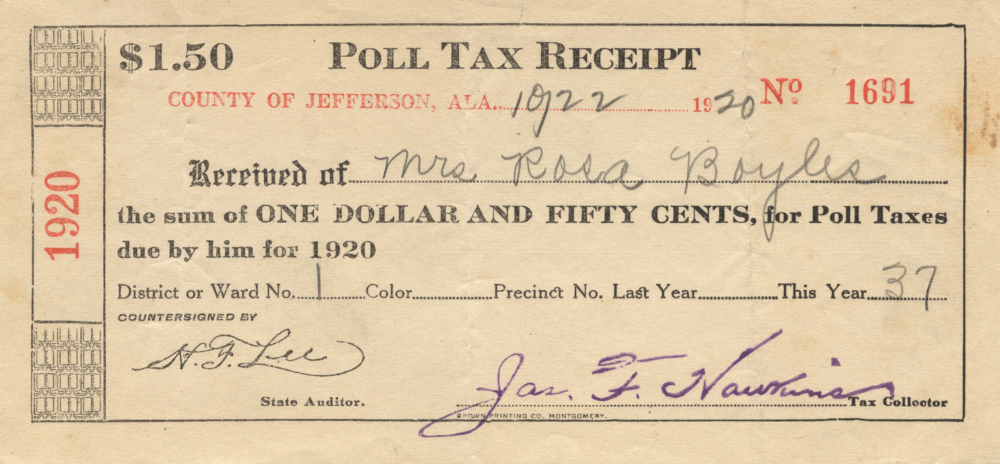
(Alabama Department of Archives and History)
Even states that acted to help more women register had other barriers to voting. Both Connecticut and Massachusetts required a literacy test. Prior to the election, Massachusetts added a poll tax, while Connecticut instituted a morals clause and a long residency requirement.
How could so many women be prevented from voting when the U.S. Constitution had just been amended to allow women to vote?
The 19th Amendment does not actually guarantee women the right to vote.

Rather than endorse the fundamental right of every American woman to vote, the amendment states merely that the right of U.S. citizens to vote cannot be abridged on the basis of sex.
In other words, a woman can’t be prevented from voting just because she’s a woman. Any other cause a state might find to suppress her vote, however, might still be considered fair game.
“The colored women… will be shamefully treated”
To prevent Black women from voting in 1920, local governments employed a variety of voter suppression tactics—including poll taxes, literacy tests, and stringent residency requirements—just as they had done with Black men ever since the 15th Amendment, passed 50 years earlier, had prohibited the denial of the right to vote based on race, color, or previous condition of servitude.
Black women in Delaware showed up at the polls in droves. Many were turned away due to failure “to comply with the constitutional tests.”

(Library of Congress)
“The colored women of the South will be shamefully treated, and will not be alowed [sic] to vote, I am sure. I hope the Republicans will do something toward enforcing the Fifteenth Amendment. We are so helpless without the right of citizenship in that section of the country where we need it most.”
—Mary Church Terrell, October 1920
In Richmond, Virginia, voter registration offices were overwhelmed prior to the election. The city appointed three additional registrars, but only for white women. Black women seeking to register endured long lines and wait times, as potential voters were questioned and challenged.

In addition to government efforts to limit voting, entities such as the Ku Klux Klan instituted their own voter suppression tactics. In 1922, the Topeka State Journal reported that members of the KKK flew over Oklahoma City’s Black neighborhoods and dropped cards warning people to be cautious before heading to the polls.
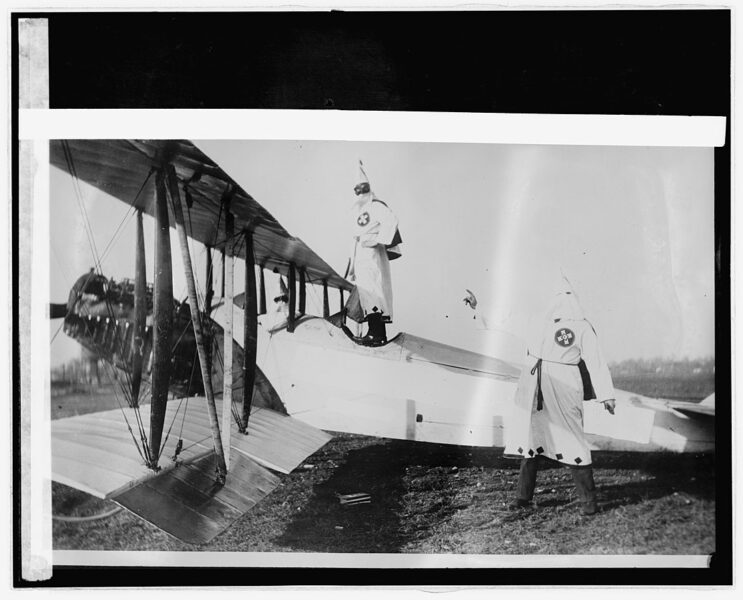
In 1926 in Birmingham, Alabama, a group of Black women were beaten when they attempted to register to vote.
In the face of violence and intimidation, Black women would continue the struggle for voting rights for another half century, helping to secure the passage of the landmark Voting Rights Act of 1965.


“No dogs, no negroes, no Mexicans”
States could, and did, use similar voter suppression tactics against people of Hispanic heritage.
English language requirements disenfranchised Hispanic voters in some areas. This would not be rectified until the Voting Rights Act of 1965 prohibited electoral practices that abridged the rights of language minorities. (A 1975 amendment to the act stipulated that states provide voting materials in languages other than English.)

Meanwhile, several southern states including Texas had laws stipulating that only white people could vote in primaries. In practice, this often meant the exclusion of Latinos as well as Black people.
New Mexico in 1920 was unique. It had just become a state, and Anglos were a minority. Spanish-speaking women in Nuevo Mexico had political advantages not enjoyed by Latinas in other states. Hispanic suffragists, having played a crucial role in ratifying the 19th Amendment, would help to elect many Latinas in the years after suffrage.

“This is a white man’s neighborhood”

Many Asian American women couldn’t vote in 1920 because they lacked citizenship. Assorted immigration laws prevented most Asian immigrants to America from naturalizing as citizens. Those exclusionary policies wouldn’t begin to change until the 1940s. Naturalization restrictions were lifted for Chinese Americans in 1943, Filipino and Indian Americans in 1946, and finally all Asian Americans in 1952.


Non-citizens in their native land
Similarly, Native American women like suffragist Zitkala-Sa weren’t allowed to vote in 1920. Not because they were women, but because as indigenous people they did not enjoy the benefits of U.S. citizenship.

Zitkala-Sa, also known as Gertrude Simmons Bonnin, continued the campaign for suffrage after the 19th Amendment, helping to secure passage of the Indian Citizenship Act of 1924. Later she co-founded the National Council of American Indians dedicated to uniting the tribes and using the vote to improve the welfare and legal status of Indian communities.
Being able to vote in the white man’s government was essential to promoting and protecting indigenous rights. But enfranchisement was nothing new to native women, many of whom came from matrilineal, matriarchal, or egalitarian societies where for generations women had governed alongside men.

In 1920, the benefits of woman suffrage were enjoyed mostly by white women.
Though certainly not all white women. And as women who were able went to the polls in November 1920, many must have been keenly aware of the rights still denied to them.
For example…
A woman in 1920 couldn’t get a passport in her own name.
Only her husband’s.

Women weren’t allowed to serve on a jury in most states.
By the end of the decade, half of states had begun to allow women on juries, though with restrictions in many cases. Half a century later, Ruth Bader Ginsburg (1933–2020) would go to the Supreme Court to challenge the validity of voluntary jury duty for women. Ginsburg successfully argued that participation in jury duty was a citizen’s vital governmental service and therefore should not be optional for women.

Women could not enlist in the military or receive benefits.
This, despite women having served on the front lines during World War I as nurses and ambulance drivers. Though many endured the same lasting psychological trauma that impacted male soldiers, women wouldn’t be allowed to enlist and receive benefits until the Women’s Armed Services Integration Act of 1948.
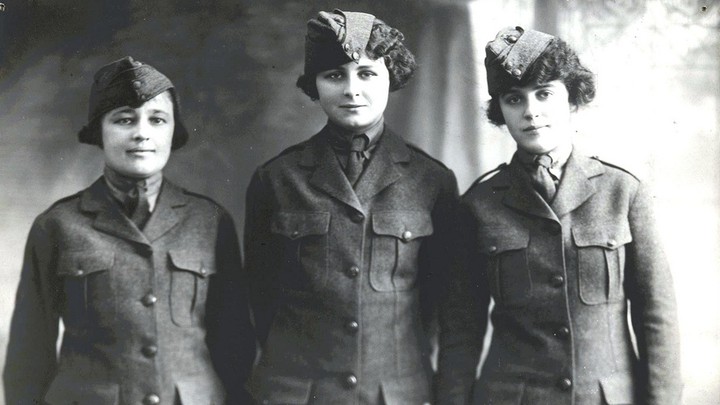
A woman could be fired for being pregnant.
Legal protections for working mothers did not come about until the 1970s. Meanwhile, women in 1920 had little access to contraception and no safe, legal way to terminate a pregnancy. Thousands of women died each year from abortions.
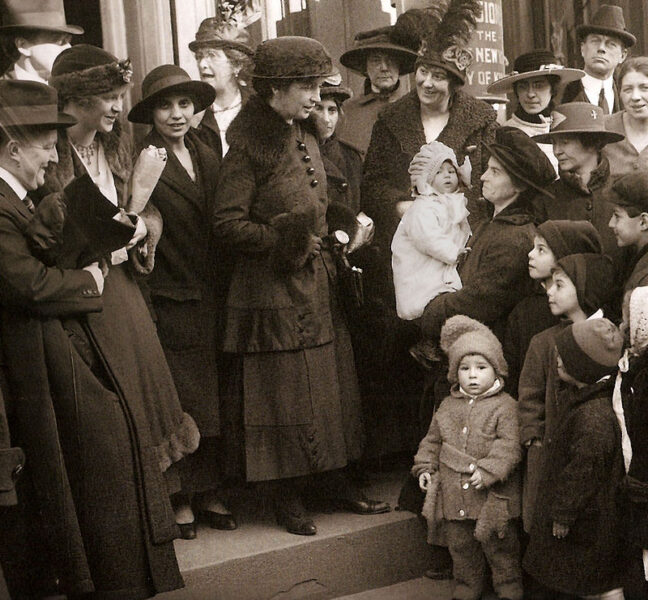
Women had no wage protection under the law.
Women comprised 20 percent of the paid labor force in 1920. World War I had opened up many opportunities for working women, though not necessarily in regard to equal pay.
In June 1920, the Women’s Bureau of the U.S. Department of Labor was established to advocate for women in the workplace. The Women’s Bureau, according to DOL.gov, remains “the only federal agency mandated to represent the needs of wage-earning women in the public policy process.”
Even so, advancing opportunities for women’s profitable employment takes time. The Fair Labor Standards Act of 1938 would establish a minimum wage without regard to sex. Women would not be legally entitled to equal pay until 1963. In 2020 women still earn less than men.

Women voters got to choose one man or another.
Female candidates were few and far between. Unless you lived in Yoncalla, Oregon, where women had had the vote since 1912. There, dissatisfied with the performance of male leaders, women took control of all government positions in 1920. The town council of Jackson, Wyoming (another early adopter of women’s suffrage) was comprised solely of women from 1920-23.
Elsewhere, women campaigned to get more female candidates elected to office.

There was just one woman in Congress.
Jeannette Rankin of Montana was elected to the House of Representatives in 1916, just two years after women in her state achieved suffrage.

Over the past 100 years, women have gradually taken their place in the House and Senate and now occupy 25 percent of Congressional seats. How long until women and men represent their states and districts in equal numbers? At this rate, it could be another 100 years.
Or sooner, perhaps. More and more, women are exercising their voting power.
The 1964 presidential election marked a milestone: For the first time, women voters outnumbered men, a trend that has continued in every national election since. In the 1980 presidential election, and everyone since, the proportion of women voting has been higher than that of men. That is, a higher percentage of eligible female voters go to the polls than do their male counterparts.
Historically, American women have not coalesced often around a single issue or candidate. Women’s political opinions are as diverse as those of men. If there is one thing we can be certain about as American women prepare to cast their ballots in the election that marks the 100th anniversary of their right to vote, it’s that their power to make their voices heard is greater than ever.

